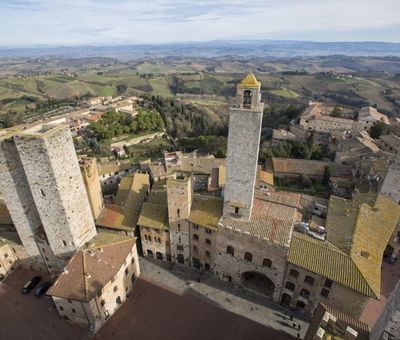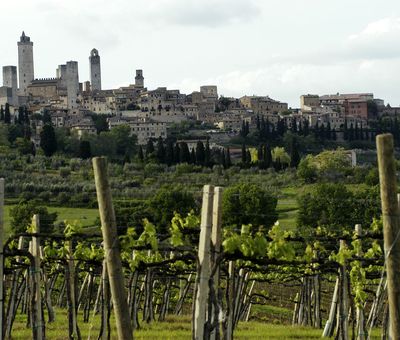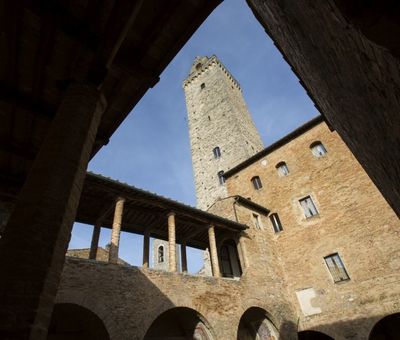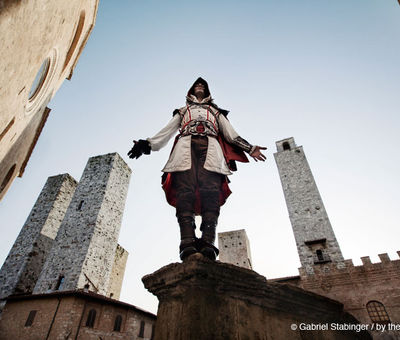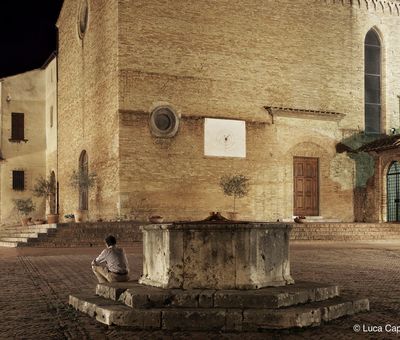A hospitable city on the Via Francigena
San Gimignano is an ancient place of hospitality, at least since as far back as the days when pilgrims travelled the Via Francigena. Already in 1262, there were as many as nine hospitia (hospices), only a few less than those found in Siena. Since the Middle Ages, merchants, coachmen and pilgrims have been welcomed here, just as today we welcome visitors and all those who have chosen to live a new and more naturalistic life far from the noise of the big cities.
A countryside rich in fragrances and flavours
The countryside embraces the Old Town. Grape vines adorn the fields just outside the walls. The land is rich. In the Middle Ages, it already produced saffron and Vernaccia, a wine loved by Dante Alighieri, Boccaccio and Michelangelo Buonarroti and always present at Medici banquets. Vernaccia, a white in the land of reds, was the first DOC (controlled designation of origin) in Italy in 1966 and is today appreciated all over the world. The same can be said for the local saffron, which is the only saffron in Tuscany to hold DOP (protected designation of origin) status. It’s a beautiful violet flower that blooms in late October and from which you collect the stigmas that were so prized in the Middle Ages, they were exchanged in the weight of gold. Today at the Spezieria di Santa Fina, you can see old apothecary recipes and precious containers.
Medieval vertigo
Thanks to its strategic position and these goods, San Gimignano was home to many rich families in 1200s. These families filled the city with towers to show off their wealth, assert their power and defy gravity and the sky. To curb this superb challenge, the Prior decided in 1300 to build the Torre Grossa: the tallest of them all and the limit to which no one could afford to pass. And so it is still the tallest tower, overlooking the Piazza del Duomo and boasting one of the most magnificent views of Tuscany. The centre of San Gimignano has been UNESCO heritage listed since 1990.
A film set in the open air
But after so much wealth, the decline of the modern age arrived. In the 1600s, instead of decorating the facades in the style of the time and changing the face of the city as they did almost everywhere, San Gimignano’s families, living in poverty, kept the towers in their original state. The misfortune of our 17th-century ancestors paved the way to our modern fortune. Already in 1857, the towers were featured in the Baedeker guide and the English, the French, the world began to fall in love with the city. San Gimignano soon became an open-air film set, featuring in the "Prince of Foxes" (1949) by Henry King and starring Orson Welles, "Brother Sun, Sister Moon" (1971), "Tea with Mussolini" (1999) by Franco Zeffirelli and "The Meadow" (1979) by the Taviani brothers with a beautiful Isabella Rossellini. Beyond reality and into the virtual, San Gimignano is also the set of the game Assassin's Creed.
A word in your ear
But can we give some insiders’ advice? Come in winter or early spring and be one of the first to discover a more intimate version of San Gimignano that will remain in your heart.


